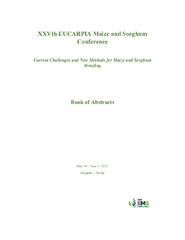Приказ основних података о документу
Non-parametric yield stability analysis of zp maize hybrids in serbia
| dc.contributor | Anđelković, Violeta | |
| dc.contributor | Srdić, Jelena | |
| dc.contributor | Nikolić, Milica | |
| dc.creator | Branković-Radojčić, Dragana V. | |
| dc.creator | Babić, Vojka | |
| dc.creator | Petrović, Tanja | |
| dc.creator | Milivojević, Marija | |
| dc.creator | Jovanović, Snežana | |
| dc.creator | Popović, Aleksandar | |
| dc.creator | Srdić, Jelena | |
| dc.date.accessioned | 2022-06-07T07:10:23Z | |
| dc.date.available | 2022-06-07T07:10:23Z | |
| dc.date.issued | 2022 | |
| dc.identifier.isbn | 978-86-80383-15-6 | |
| dc.identifier.uri | http://rik.mrizp.rs/handle/123456789/954 | |
| dc.description.abstract | High and stabile yield in different production environments is priority in maize breeding. New statistical methods are constantly being sought to accompany analysis of variance, in order to achieve more reliable hybrid assessment. In this study non-parametric stability analysis is applied in order to assess GxE interaction for yield of 36 commercial maize hybrids. The experiment was set up at five locations in Serbia for three years according to the RCBD design in three replications. Yield stability of investigated genotypes was analysed by stability parameters Si(1), Si(2), Si(3), Si(6), TOP and RS. Analysis of variance identified highly significant F values for all experimental factors. Bredenkamp method confirmed the existence of non crossover GxE interaction, for maize yield. Hybrid ZPH15 achieved the most stable yield based on parameters Si(1) and Si(2). According to parameter Si(3) it was ZPH5, while based on parameter Si(6) it was ZPH34. The highest overall yield achieved ZPH36 (11.18 t/ha), which was quite unstable (rank 24 in parameters Si(1) and Si(2)), and very unstable (rank 34 in parameters Si(3) and Si(6)). The most stable hybrids had average yields. In total, the hybrid ZPH23 had the best average rank (15.93). Based on TOP parameters, ZPH36 had the best rank (yield), followed by ZPH11, ZPH20, ZPH21 and ZPH9. However, RS parameter, revealed that ZPH21 was the most stable hybrid, so taking into account both TOP and RS parameters this is the most productive and the most stable hybrid. Based on this research, TOP and RS are the best parameters for selecting new maize hybrids for production in particular environment. In case of identical TOP value, the genotype with the lowest RS value should be selected. The parameters Si(1), Si(2), Si(3) and Si(6) can be used as alternative methods for the selection of genotypes with moderate yield and high stability. | sr |
| dc.language.iso | en | sr |
| dc.publisher | Belgrade : Maize Research Institute, Zemun Polje | sr |
| dc.rights | openAccess | sr |
| dc.rights.uri | https://creativecommons.org/licenses/by/4.0/ | |
| dc.source | 25. EUCARPIA Maize and Sorghum Conference:"Current challenges and new methods for maize and sorghum breeding", 30.05-02.06.2022., Belgrade - Book of abstracts | sr |
| dc.subject | maize | sr |
| dc.subject | yield | sr |
| dc.subject | GxE interaction | sr |
| dc.subject | stability | sr |
| dc.subject | non-parametric | sr |
| dc.subject | analysis | sr |
| dc.title | Non-parametric yield stability analysis of zp maize hybrids in serbia | sr |
| dc.type | conferenceObject | sr |
| dc.rights.license | BY | sr |
| dc.citation.epage | 46 | |
| dc.citation.epage | 46 | |
| dc.identifier.fulltext | http://rik.mrizp.rs/bitstream/id/4670/bitstream_4670.pdf | |
| dc.identifier.rcub | https://hdl.handle.net/21.15107/rcub_rik_954 | |
| dc.type.version | publishedVersion | sr |


